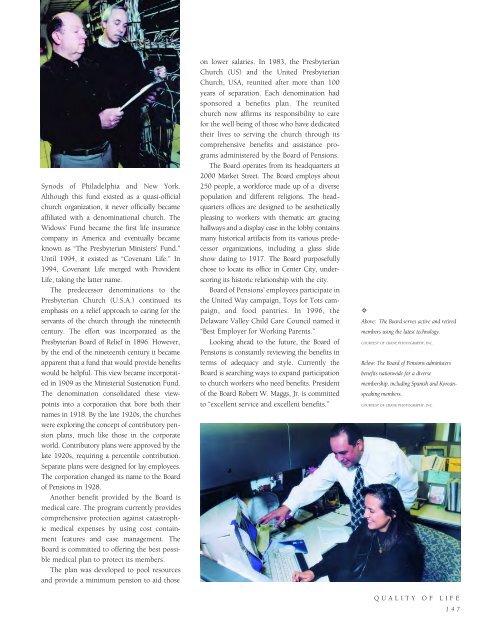Historic Philadelphia
An illustrated history of the city of Philadelphia, paired with the histories of companies, families and organizations that make the region great.
An illustrated history of the city of Philadelphia, paired with the histories of companies, families and organizations that make the region great.
Create successful ePaper yourself
Turn your PDF publications into a flip-book with our unique Google optimized e-Paper software.
Synods of <strong>Philadelphia</strong> and New York.<br />
Although this fund existed as a quasi-official<br />
church organization, it never officially became<br />
affiliated with a denominational church. The<br />
Widows’ Fund became the first life insurance<br />
company in America and eventually became<br />
known as “The Presbyterian Ministers’ Fund.”<br />
Until 1994, it existed as “Covenant Life.” In<br />
1994, Covenant Life merged with Provident<br />
Life, taking the latter name.<br />
The predecessor denominations to the<br />
Presbyterian Church (U.S.A.) continued its<br />
emphasis on a relief approach to caring for the<br />
servants of the church through the nineteenth<br />
century. The effort was incorporated as the<br />
Presbyterian Board of Relief in 1896. However,<br />
by the end of the nineteenth century it became<br />
apparent that a fund that would provide benefits<br />
would be helpful. This view became incorporated<br />
in 1909 as the Ministerial Sustenation Fund.<br />
The denomination consolidated these viewpoints<br />
into a corporation that bore both their<br />
names in 1918. By the late 1920s, the churches<br />
were exploring the concept of contributory pension<br />
plans, much like those in the corporate<br />
world. Contributory plans were approved by the<br />
late 1920s, requiring a percentile contribution.<br />
Separate plans were designed for lay employees.<br />
The corporation changed its name to the Board<br />
of Pensions in 1928.<br />
Another benefit provided by the Board is<br />
medical care. The program currently provides<br />
comprehensive protection against catastrophic<br />
medical expenses by using cost containment<br />
features and case management. The<br />
Board is committed to offering the best possible<br />
medical plan to protect its members.<br />
The plan was developed to pool resources<br />
and provide a minimum pension to aid those<br />
on lower salaries. In 1983, the Presbyterian<br />
Church (US) and the United Presbyterian<br />
Church, USA, reunited after more than 100<br />
years of separation. Each denomination had<br />
sponsored a benefits plan. The reunited<br />
church now affirms its responsibility to care<br />
for the well being of those who have dedicated<br />
their lives to serving the church through its<br />
comprehensive benefits and assistance programs<br />
administered by the Board of Pensions.<br />
The Board operates from its headquarters at<br />
2000 Market Street. The Board employs about<br />
250 people, a workforce made up of a diverse<br />
population and different religions. The headquarters<br />
offices are designed to be aesthetically<br />
pleasing to workers with thematic art gracing<br />
hallways and a display case in the lobby contains<br />
many historical artifacts from its various predecessor<br />
organizations, including a glass slide<br />
show dating to 1917. The Board purposefully<br />
chose to locate its office in Center City, underscoring<br />
its historic relationship with the city.<br />
Board of Pensions’ employees participate in<br />
the United Way campaign, Toys for Tots campaign,<br />
and food pantries. In 1996, the<br />
Delaware Valley Child Care Council named it<br />
“Best Employer for Working Parents.”<br />
Looking ahead to the future, the Board of<br />
Pensions is constantly reviewing the benefits in<br />
terms of adequacy and style. Currently the<br />
Board is searching ways to expand participation<br />
to church workers who need benefits. President<br />
of the Board Robert W. Maggs, Jr. is committed<br />
to “excellent service and excellent benefits.”<br />
✧<br />
Above: The Board serves active and retired<br />
members using the latest technology.<br />
COURTESY OF CRANE PHOTOGRAPHY, INC.<br />
Below: The Board of Pensions administers<br />
benefits nationwide for a diverse<br />
membership, including Spanish and Koreanspeaking<br />
members.<br />
COURTESY OF CRANE PHOTOGRAPHY, INC.<br />
QUALITY OF LIFE<br />
147
















